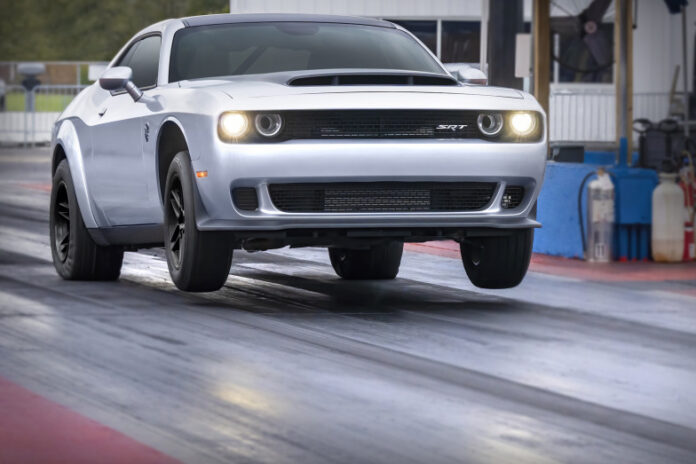When Dodge unveiled the first-ever Hellcat-powered Challenger SRT in 2014, the temple columns shook.
More powerful than many exotics at the time thanks to its 6.2 L V8 topped with a supercharger of a volume comparable to that of a “big” four-cylinder (2.4 L), it advanced 707 hp to rekindle hostilities in this war for power among American muscle cars. The American brand closed last week the final chapter of this thundering epic of Dodge, the curtain of which will fall at the end of the year.
Outrageous and unbridled, this Challenger SRT Hellcat has ever since held the top of the raw horsepower charts against the Mustang Shelby and Camaro ZL1 of this world with its multiple liveries. She will also have been the main character of an American story, where the coupe personified the self-made man from a modest background who attacked much better off rivals. Because this Challenger will always have been based on “a rental vehicle”, thus allowing it to be rather affordable in terms of its performance potential.
The last pages were lithographed a few days ago with the unveiling of the very last version to carry a Hellcat engine. It is called SRT Demon 170, to refer to its engine derived from the Hellephant C170. So it’s still a supercharged 6.2L V8 as the original that serves as the base material. However, it has been radically revised. Its supercharger, now 3L in volume, boosts air pressure to 21.3psi to ensure peak power of 1025hp and 945lb-ft of torque when fueled at E85 ethanol.
To ensure that this prodigious energy can be resisted, all the internal parts of the V8 have been strengthened and the fuel injection system improved to deliver up to 621 L of gasoline per hour to the cylinders. When the drag race is over, a cooling system kicks in, using the vehicle’s air conditioner to cool the hot compressor.
Above all, this Challenger SRT 170 is cut out for this type of event. It excels at it, if we judge by the figures put forward by Dodge. The famous quarter mile (402 m) is completed in 8.91 s with a top speed of 243 km/h, making it the fastest production car on this measuring point. During the exercise, it reaches 97 km/h in just 1.66 seconds, not without lifting the front wheels. During this time, the driver takes twice his weight in longitudinal acceleration. Mind-blowing, you say? Fortunately, you can equip it with a parachute to slow its momentum at the end of this straight line.
Obviously, such an edition will have a print run worthy of its exceptional status. Only 3300 copies will be produced, including 300 for the Canadian market. We’re betting they’ll fetch a lot more value than the starting price in Canada, set at $130,890. The end of a crazy era to probably give way to an electrical sector that promises to be already extremely efficient, but less charismatic in mechanical terms.















